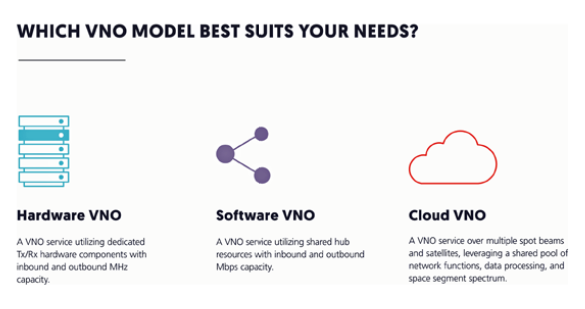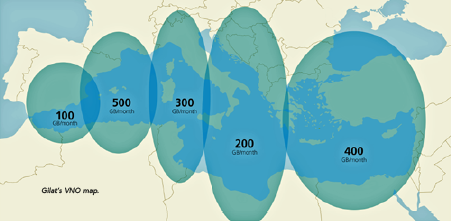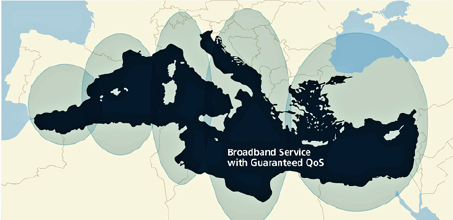We all know that the introduction of networks based on multi-spot beam satellites has reduced bandwidth costs.

The happy result is that satellite capacity, previously priced out of reach for many service providers, is now economically viable. What may be less apparent at first glance is how this new reality creates opportunities for Virtual Network Operators (VNOs).
VNOs are essentially resellers of network services, service providers with their own end users. They typically offer broadband, enterprise and cellular services to their subscriber base.
Generally speaking, VNOs are less concerned with the technicalities of a satellite network and more concerned with providing quality service. In this article, we’ll dive a bit deeper into how VNO models work and we’ll also peek around the corner to see some of the features that HTS-enabled “Cloud VNOs” are likely to provide.
The HNO/VNO Partnership
Typically, a Host Network Operator (HNO) is a satellite operator or teleport owner with satellite capacity. An HNO sells hosted network services or complete managed service to VNOs.
With the introduction of High Throughput Satellites (HTS), however, we’re seeing changes to the traditional satellite service value chain. In the past, an HNO would sell satellite services on a wide beam to a VNO.
However, as multi-spot beams become more common, VNO presence on a single beam may not be sufficient; a geographic region once covered by a single wide beam may instead be covered by several smaller beams. In this case, the model of a per-beam VNO loses its appeal. The question then becomes—what becomes of the VNO who wants to expand or even just keep pace—during this wide-beam-to-HTS conversion?
This is where opportunity awaits. VNOs are poised to emerge from this transition stronger than ever. The rollout of HTS clears a path for HNOs to offer dynamic wholesale services, expanding possibilities for network sharing. Looking ahead, by combining a software-defined network and cloud-based architecture, HNOs can offer a new breed of services—rich, cloud-based packages that VNOs can use to attract subscribers.
Change Is In The Air…
To appreciate where the VNO world is heading, we need to understand where it is now. Currently, satellite networks can be shared in any number of ways. In some models, the HNO controls the hub infrastructure and controls network operations. In others, the HNO controls only the hub infrastructure while the VNO controls network operations. The permutations of this shared model are endless. But what are the benefits?
Let’s take a closer look at three types of VNO models that enable HNOs to deliver B2B VNO wholesale services. “Hardware” and “Software” are long-standing VNO models suited for wide-beam, while an emerging third model, “Cloud”, includes HTS-specific features as well.
Hardware VNOs
For satellite service providers requiring full control over their network operations, Hardware VNO is an ideal solution. Hardware VNO uses dedicated transmit/receive hardware components with inbound and outbound MHz capacity.
The VNO controls satellite resources, software update scheduling, and configuration of all hardware elements. By supplying VNOs with a separate network and independent management capabilities, HNOs can offer VNOs the opportunity to run their own services without requiring upfront investment in teleport infrastructure.

Software VNOs
To achieve a lower price point for satellite capacity and reduce CAPEX, a software VNO solution fits well. Software VNO is a managed network, supporting applications from broadband to mobility and uses shared hub resources with inbound and outbound Mbps capacity. In this model, the HNO can generate detailed data usage records per VSAT, enabling pay-per-use business models.
The VNO does not invest in hardware; rather, the VNO uses the HNO’s infrastructure and selects a range of service options covering quality of service (QoS), rate and quota. The VNO can also offer redirect services, as the shared resources are transparent to the end user.
Cloud VNOs
For VNOs seeking to enter HTS-driven networks with minimal overhead, Cloud VNO is an optimal point of entry. Cloud VNO offers service over multiple spot beams and satellites, leveraging a shared pool of network functions, data processing, and space segment spectrum. Enabling rapid introduction of new services and business models, this model scales as the business grows.
The Cloud VNO model, coupled with recent developments in Software Defined Networking (SDN), allow HNOs to offer some of the most powerful features of modern networks, such as capacity on demand and guaranteed QoS across beams and satellites.
In this Cloud QoS construct, QoS is a cloud function and is no longer managed at a carrier or beam level. Rather than determining how much bandwidth is needed in a given beam’s footprint and having that amount of GB/month statically allocated, the VNO receives a service-level agreement for a multi-beam service area.
This model is uniquely enabled by HTS. The flexibility to reallocate bandwidth across beams opens the door to offering services on demand rather than an allotment of satellite capacity per region. One obvious use case for this is mobility services across multiple spot beams. Services are managed at the network level as the VSATs move between beams or satellites.

Anticipating trends in the satellite industry, the Cloud VNO model supports features that are quickly becoming standard. Network-on-demand enables VNOs to boost bandwidth for a limited time in a given location, e.g., an outdoor amphitheater that requires a bandwidth increase when hosting a weekend festival.
Another feature is backup-on-demand, in which a satellite network is activated in place of a terrestrial network with damaged infrastructure. Satellite networks are often a preferred backup for terrestrial networks because they are quick to deploy and do not rely on the same infrastructure.
Looking even further ahead, a Cloud VNO model will enable on-the-fly bandwidth adjustment based on analysis of traffic patterns or due to a sudden spike in demand. An example of this would be a decision to reallocate bandwidth to and from an island frequented by vacationers in the summer but sparsely populated most of the year. Functionality of this type will become widespread with the next generation of satellites, scheduled for launch in the near future.
Features such as these are rapidly becoming integral to network operations; they are also features that VNOs will be expected to provide.

…And Change Is On The Ground
While powerful and exciting in its potential, a cloud-based VNO can only be offered when backed by ground segment architecture designed to support HTS, multiple services and multiple beams. Most ground segment architectures in use today are not able to offer these features, so selecting a platform that includes these features is vital. In addition, a service-oriented network management system is needed to enable HNOs to rapidly introduce VNO entities and guarantee the VNO service level.
From the VNO perspective, by accessing a network management system they can simply operate their network and concern themselves with business decisions rather than the technicalities of running a satellite-based system.
How do you determine which VNO model your network needs? The answer usually is—it depends. Considering business imperatives and how your network is structured, it may well be that several models are needed.

At Gilat, we believe that the global trend toward network virtualization will lead to predominately Cloud VNO models. We also understand that what works for your network today may change tomorrow. Business opportunities can often carry you in unexpected directions. Gilat’s SkyEdge II-c with X-Architecture, a single platform supporting all VNO models, provides you with the flexibility to prepare for any eventuality.
gilat.com/x-architecture
Ezra Olman (ezrao@gilat.com) is Content Marketing Manager for Gilat Satellite Networks. In this role, Olman is responsible for content creation, from articles and white papers to case studies and social media posts. He also designs and manages marketing automation campaigns.



